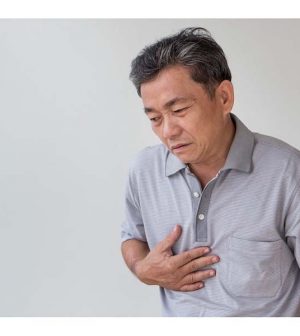- Skip Storing This Everyday Product in the Fridge Door
- Green Tea + B3 Pairing May Boost Brain Health
- Navigating Your Midlife Crisis: Embracing New Possibilities
- City Raccoons Showing Signs of Domestication
- Mapping the Exposome: Science Broadens Focus to Environmental Disease Triggers
- One Week Less on Social Media Linked to Better Mental Health
- Your Brain Changes in Stages as You Age, Study Finds
- Some Suicide Victims Show No Typical Warning Signs, Study Finds
- ByHeart Formula Faces Lawsuits After Babies Sickened With Botulism
- Switch to Vegan Diet Could Cut Your Greenhouse Gas Emissions in Half
1 in 4 Heart Attacks Arrive With ‘Atypical’ Symptoms

A quarter of heart attack patients have atypical symptoms and are less likely to receive emergency care, Danish research reveals.
These patients are also more likely to die within 30 days than those with chest pain.
Atypical heart attack symptoms include breathing problems, extreme exhaustion and abdominal pain.
“Atypical symptoms were most common among older people, especially women, who called a non-emergency helpline for assistance,” said study author Amalie Lykkemark Møller, a doctoral student at Nordsjællands Hospital in Hillerød, Denmark. “This suggests that patients were unaware that their symptoms required urgent attention.”
For the study, she and her colleagues analyzed data on heart attack-related calls to a 24-hour medical helpline and an emergency number in Denmark between 2014 and 2018. They were looking for adults 30 and older who were diagnosed with heart attacks within 72 hours of the call.
Of the 8,336 heart attacks they found, a specific primary symptom was recorded for 7,222. Chest pain was the most common (72%).
Twenty-four percent of patients had atypical symptoms, with breathing problems being the most common.
Rates of chest pain were highest among 30- to 59-year-old men who called the emergency number and lowest among women over 79 who called the non-urgent helpline. Atypical symptoms occurred mainly in older patients, especially women who called the helpline.
Among callers with chest pain, 95% were sent help through the emergency number, compared to 62% of those with atypical symptoms.
Seventy-six percent of helpline callers with chest pain were sent a dispatch, compared to 17% of those with atypical symptoms, the analysis found.
It also revealed that 5% of patients with chest pain died within 30 days of calling the emergency number, as did 3% of those who called the non-urgent helpline.
That compared with 23% of emergency callers who had atypical symptoms and 15% of those who called the helpline.
After accounting for factors that could affect the results, including age, sex, education, diabetes, previous heart attack, heart failure and chronic obstructive pulmonary disease, researchers pegged 30-day death rates at 4.3% for patients with chest pain and 15.6% for those with atypical symptoms.
The findings were published May 6 in the European Heart Journal – Acute Cardiovascular Care.
“Taken together, our results show that heart attack patients with chest pain were three times more likely to receive an emergency ambulance than those with other symptoms,” Møller said in a journal news release.
“People with atypical symptoms more often called the helpline, which could indicate that their symptoms were milder, or they were not aware of the severity,” she said. “Vague symptoms may contribute to health staff misinterpreting them as benign.”
More information
The American Heart Association outlines the warning signs of a heart attack.
SOURCE: European Heart Journal – Acute Cardiovascular Care, news release, May 6, 2021
Source: HealthDay
Copyright © 2025 HealthDay. All rights reserved.










